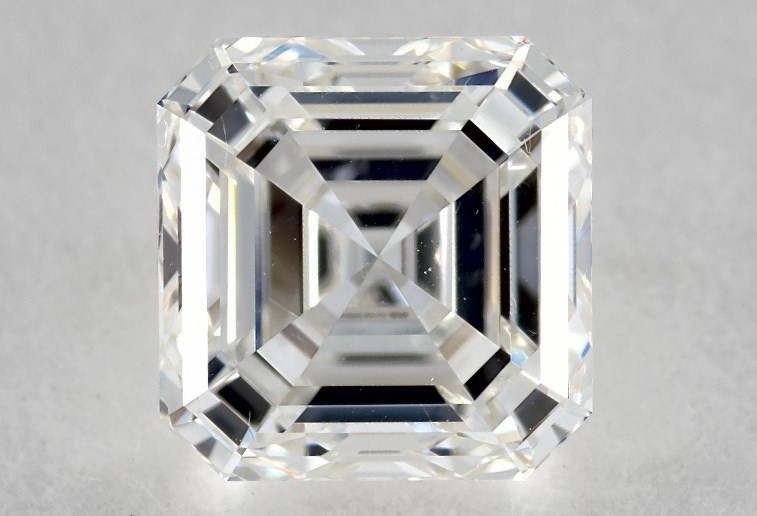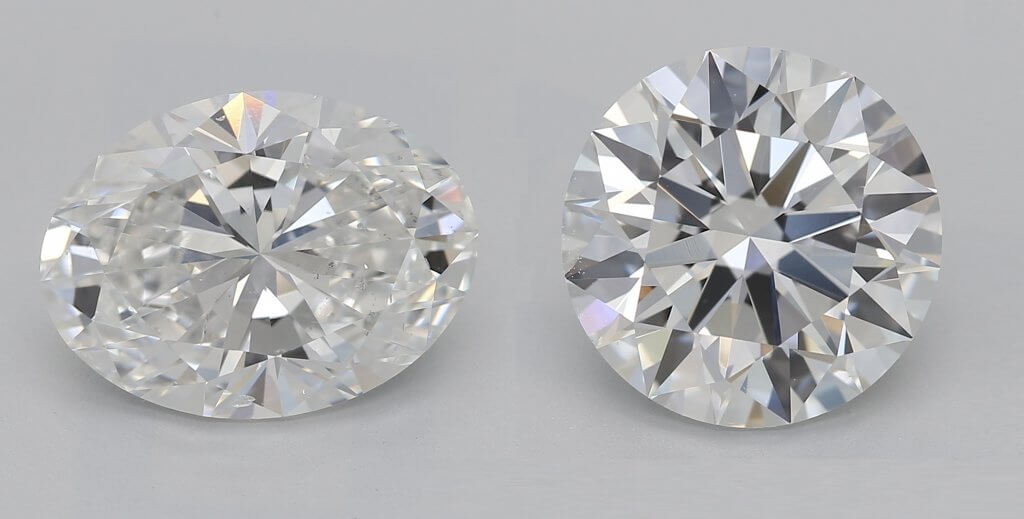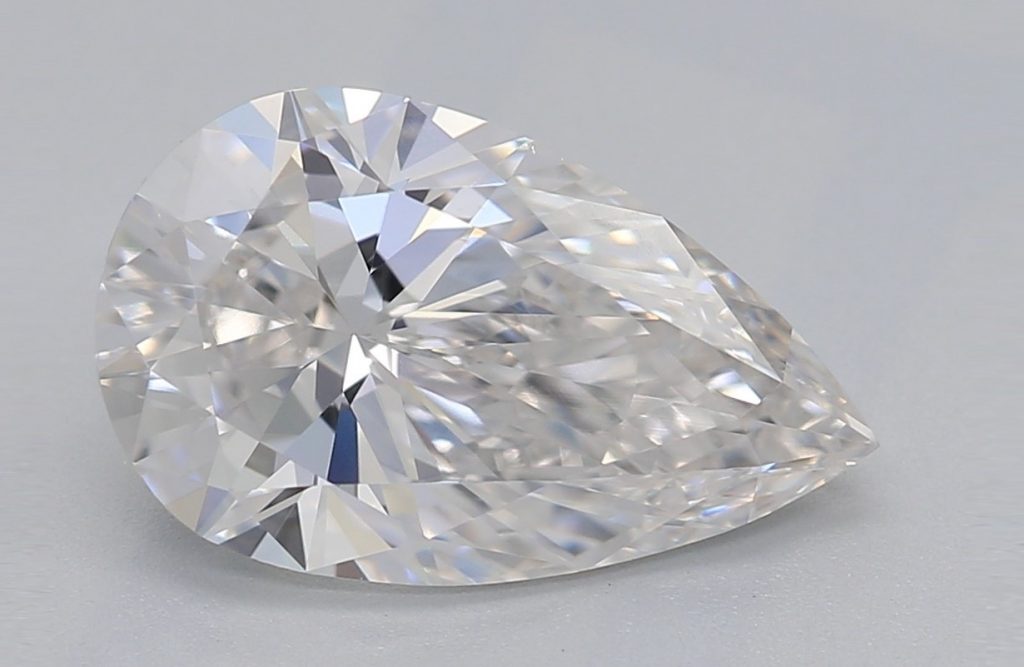The Timeless Elegance of an Asscher Cut Diamond: How to Choose the Perfect One?
Key Takeaways
- The Asscher is a beautiful interpretation of the step cut, which is what gives it its distinctive and elegant ‘hall of mirrors’ effect.
- Like the Emerald, the Asscher is lacking the bright sparkle of the Round Brilliant, and modified brilliants like the Cushion and Radiant, but that doesn’t have to be a dealbreaker – it’s just worth considering if your partner is a fan of diamond’s signature fire and brilliance.
- Clarity is a key consideration when you’re looking at Asscher cut diamonds, since the larger facets are not so effective at obscuring minor inclusions.
- The Asscher is ideal for any vintage ring designs – particularly those that are inspired by the Art Deco styles of the 1920s.

In spite of the undeniable popularity of the brilliant cuts – and, of course, their exceptional sparkle – there is no avoiding the fact that the step cuts boast their own, unique allure.
They represent a subtler, more understated way of showcasing the beauty of diamond. Their seemingly endless, geometric depths create an incredibly sophisticated centerpiece for any engagement ring, and prove that maximum sparkle is not quite everything when it comes to finding a beautiful diamond.
This is why the Asscher cut has grown so popular since its creation more than a century ago – and why you should definitely consider adding it to your list of contenders.
What is an Asscher Cut Diamond?
A step cut diamond featuring a square shape with beveled corners, known for its elegance and glassy shine
An Asscher cut diamond is a square with a length to width ratio of 1.00, and the angular, beveled corners you will likely recognize from the Emerald cut.
The cut features large step facets and a high crown that results in a stunning brilliance, creating the optical illusion known as the “Hall of Mirrors” effect that draws so many of us toward the step cuts.
A well-cut Asscher diamond will appear to have concentric squares as you look down through the table, resulting from the proper positioning of the pavilion facets underneath.
What is the Difference Between Asscher Cut and Emerald Cut?
While the cut does resemble an Emerald cut, there is a key difference. The Asscher achieves that hall of mirrors effect in the square form instead of a rectangle. However, Square Emerald cuts do exist…
The two cuts are so similar, however, that the Asscher cut is often times referred to as a Square Emerald cut on a diamond certification, such as those issued by the GIA. It might bring about some confusion to the name of the cut, but the Asscher and Square Emerald cut are actually the same.
The rare, Royal Asscher cut, which is a patented version of the original Asscher cut, is still offered by the GIA.
Switching from square to rectangular not only impacts the appearance of both diamonds when they are placed within their settings – the Emerald can have a lengthening effect on the finger, while the width of the Asscher can make the finger appear slimmer – but it also means that the Asscher (or Square Emerald) appears larger than a rectangular Emerald cut of the same size.
Does the Asscher Cut Sparkle?
Yes, but not in the same way as the Round cut, or the modified brilliants like the Oval, Princess, Cushion or Marquise.
It seems fair to say that the most striking difference between the Asscher cut and the Round cut is the way their facets are arranged. While the Round features many smaller, pyramid-shaped facets across the crown and pavilion, the facets found on the Asscher are longer, and run parallel to the edges of the stone.
But what does this have to do with sparkle? A lot, in fact. Those smaller, more intricately placed facets found on the Round cut are responsible for the incredibly high levels of fire, brilliance, and scintillation you find in so many diamond shapes.
The elongated facets on the Asscher, however, tell a totally different story. Asscher diamonds create plenty of fire and brilliance, but the effect is calmer – a little more subdued – but still very beautiful.
Since getting that all-important sparkle right is such a big concern for so many shoppers, however, we’d always recommend going to see one of these diamonds in person before you commit to its unique attributes. You can use our Store Locator to find a reputable jeweler
near you, who will be able to introduce you to this remarkable cut’s light performance.
Is Asscher Cut Cheaper than Round?
Yes, two diamonds with the same grades for cut, clarity and color – and the same carat weight – will, in all likelihood, differ significantly in price, with the Round costing much more than the Asscher.
Nevertheless, Round diamonds are better at hiding mild inclusions than Asscher and Square Emerald diamonds, since step cut facets draw the eye deeper into the diamond. As a result, while you might find that an eye clean Round diamond is available at your desired carat weight with a more affordable clarity grade of, say, SI1, the different structure of the Asscher may mean you need to pay more for a higher clarity grade.
Are Asscher Diamonds Popular?
Yes, their chic, Art Deco style has taken pride of place in many engagement rings over the decades.
Of course, this cut isn’t able to rival the Round and Oval in terms of sheer popularity but, for many years now, the Asscher cut’s ability to draw the eye into its seemingly unending depths has ensured it a high spot on the list of top diamond shapes out there. As such, there’s no denying that the Asscher will continue to represent a classic choice for many generations to come.
What Does Asscher Cut Say About You?
Those who choose the Asscher tend to have a pretty timeless taste in fine jewelry – one that would look just as at-home in the glittering halls of the roaring 20s as it would at an elegant cocktail party today.
While the wearer of the Asscher is quite happy to sacrifice some of the brilliance and fire offered by the Round and modified brilliant cuts, their appreciation for the innate beauty of diamond – and of the skilled work of the cutter – shines bright regardless.
What is Special About Asscher Cut Diamond?
From its mesmerizing shine to its timeless look and versatility, the Asscher has a lot standing in its favor.
Not only is the Asscher cut highly sophisticated and flattering, but it also boasts a unique and fascinating history among Royalty, and Hollywood’s very own Queen, too…
The History of the Asscher Cut
The Asscher cut diamond was first produced in 1902 and named after Joseph Asscher in Amsterdam, Holland. The Asscher brothers were known for being commissioned by King Edward VII for cutting the world’s largest stone, the Cullinan, at 3,106 carats, before it was placed in the English crown jewels.
From there, the Asscher cut gained popularity in the 1920’s, but lost momentum and was only found in antique shops – a symbol of a bygone era of glamour. It wasn’t until about 100 years later, in 2002, when the cut began to make a comeback, with new cut modifications, giving the cut more brilliance than original Asscher cut diamond.
Elizabeth Taylor put the Asscher cut back in the spotlight with her infamous Krupp diamond, a gift from Richard Burton. It is one of the most famous diamonds in the world, and now known as the Elizabeth Taylor Diamond. Today, many celebrities also adorn Asscher cut diamonds on their fingers.
Choosing an Asscher Cut Diamond
The Asscher cut was designed to draw the eye into the diamond, so when choosing an asscher cut, you should always select the highest quality stone to retain its brilliance.
The Best Setting for Asscher Cut Diamonds
Asscher cut diamonds require four-pronged settings due to the shape of the cut. Because of the stunning Art Deco style of the cut, an asscher diamond looks incredible in a vintage ring setting or a halo setting to add extra sparkle to the stone.
The Asscher can look sleek and modern in a bezel setting, too, although this will prevent as much light from entering the diamond and impact its light performance as a result.
As always, a strong grade across the Four Cs is essential to choosing a beautiful Asscher cut diamond. The following cut, color and clarity guides should be taken into consideration when choosing an asscher cut diamond:
Asscher Cut Diamond Cut Guide – (Square Emerald)
The cut attributes of a diamond contribute to its sparkle and beauty. The most knowledgeable buyers would choose attributes from the Excellent – Very Good columns.
| Excellent | Very Good | Good | Fair | Poor | |
| Table % | 60 – 65.9 | 58 – 59.9 or 66 – 69.9 | 56 – 57.9 or 70 – 71.9 | 54 – 55.9 or 72 – 73.9 | <53.9 or >74 |
| Depth % | 63 – 67.9 | 58 – 62.9 or 68 – 69.9 | 56 – 57.9 or 70 – 70.9 | 54 – 55.9 or 71 – 73.9 | <53.9 or 74 |
| Girdle | Very Thin to Slightly Thick | Very Thin or Thick | Very Thin or Very Thick | Extremely Thin or Extremely Thick | |
| Culet | None | Very Small | Small | Medium | >Medium |
Asscher Cut Diamond Length-to-Width Guide
A classic Asscher cut has a length-to-width ratio of 1.00.
| Excellent | Very Good | Good | Fair | Poor | |
| Square | 1.00 – 1.029 | 1.03 – 1.05 | 1.06 – 1.08 | >1.08 | |
Asscher Cut Diamond Symmetry, Polish, Cut and Fluorescence Guide (Square Emerald)
Our experience suggests that Cut, Symmetry, Polish, and Fluorescence contribute to a diamond’s brilliance, so most buyers will choose Excellent – Very Good and Fluorescence None – Faint.
| Excellent | Very Good | Good | Fair | Poor | |
| Cut | Excellent | Very Good | Good | Fair – Poor | |
| Polish | Excellent | Very Good | Good | Fair – Poor | |
| Symmetry | Excellent | Very Good | Good | Fair – Poor | |
| Fluorescence | None | Faint | Medium | Strong – Very Strong |
Asscher Cut Diamond Color Guide (Square Emerald)
Most buyers prefer size over color hue and will buy a diamond of G color.
| Excellent | Very Good | Good | Fair | Poor | |
| < 0.50 ct. | D – G | H – I | J – K | L – M | > N |
| 0.51 – 1.00 ct. | D – F | G – H | I – J | K | > L |
| 1.00 – 2.00 ct. | D – F | G – H | I – J | K | > J |
| >2.00 ct. | D – F | G – H | I – J | K | > J |
Asscher Cut Diamond Clarity Guide (Square Emerald)
As always, finding an eye clean diamond is very important, so most shoppers will buy a diamond of VS1 – VS2 Clarity.
| Excellent | Very Good | Good | Fair | Poor | |
| < 0.50 ct. | FL – VS2 | SI1 – SI2 | I1 – I2 | > I2 | |
| 0.51 – 1.00 ct. | FL – VS1 | VS2 | SI1 – SI2 | I1 – I2 | > I2 |
| 1.00 – 2.00 ct. | FL – VVS2 | VS1 – VS2 | SI1 – SI2 | I1 | > I1 |
| >2.00 ct. | FL – VVS2 | VS1 – VS2 | SI1 – SI2 | I1 | > I1 |

Jun 28, 2022 By Willyou.net
Comparing Oval and Round Cut Diamonds: Which One is Right for You? A Guide

May 11, 2021 By Willyou.net
Cushion Cut Diamonds: The Ultimate Symbol of Brilliance and Elegance








